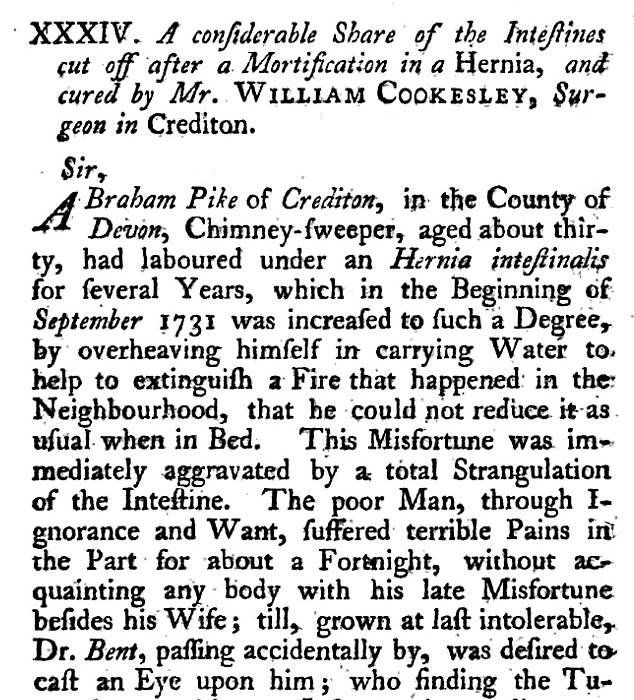William Cookesley
Little is known of William Cookesley. He would probably have been described as a “surgeon apothecary”, the forerunner of general practitioners. He lived in Crediton, where he married Sarah Creese in 1735, and had several children. In 1731 he operated on Abraham Pike, successfully performing pioneering surgery.
Abraham Pike was a 30 year old chimney sweep. He lived in Crediton with his wife Joan. He had had a groin rupture for several years. In early September 1731, he strained himself when carrying buckets of water to help extinguish a house fire (reported as an arson attack), after which his hernia became stuck and very tender.

For about two weeks he was in severe pain and constipated. Dr George Bent, a physician, was then living in Crediton and was asked to see him. He confirmed a large inflamed hernia and told him he must see a surgeon.
Local surgeon William Cookesley was sent for and attended him the next morning, by which time the inflamed skin had broken down. With his “scissars” he excised some dead bowel that was protruding, as well as some surrounding skin. Over the next few days he changed the dressings twice daily and gradually the wound became healthier, although, as he predicted, the bowel contents discharged through the wound. Whilst he thought his patient would not survive, he did not give up. He prescribed clysters (enemas) and the wound in the groin gradually healed, and the bowel habit returned to normal.
In 1742 Cookesley wrote about the operation he had performed on Pike.

He claimed that his patient was now completely cured of his hernia, had put on weight, and was healthier than he had been years before his operation. Cookesley believed that he had excised six inches of small bowel. Dr Bent corroborated the clinical details, although apparently remained sceptical that a length of small bowel had been removed.
32 years after his operation, Abraham Pike died in Crediton on 3rd January 1763, aged about 63.
News of his death must have quickly reached Dr Bent who now lived in Exeter, as the next day he came to Crediton bringing John Symons, an Exeter surgeon. Symons performed a post mortem examination and confirmed that some intestine, including the appendix, had indeed been removed.
Pike was buried at the parish church in Crediton the following day.
According to Symons, at the time of the post-mortem on Pike, William Cookesley the surgeon had been dead for many years. So he never knew that his patient was the first to survive surgical removal of the appendix. It is known that he relinquished the office of being surgeon to the poor of Crediton Parish in 1752.
(John Symons had been the pupil, and later assistant, of William Hunter - the famous Scottish anatomy teacher - in London in 1746. Symons set up practice in Exeter in 1749, and was later was appointed surgeon to the Devon and Exeter Hospital. He died a wealthy man in Exeter in 1788, “an eminent surgeon of that city, whose extensive practice and connections, and friendly disposition, render his loss generally lamented”. According to his will he had no immediate family.)
by Peter Selley
